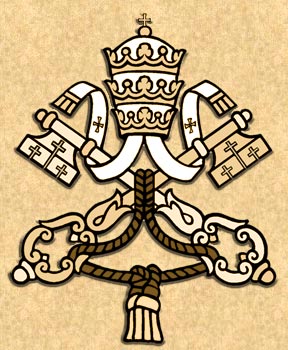
St. Bridget of Sweden
St. Bridget of Sweden (1303-1373), whom John Paul II proclaimed as co-patroness of Europe, was the subject of Benedict XVI's catechesis during his general audience held this morning in St. Peter's Square.
The life of the saint, born in at Finister in Sweden, may be divided into two periods. During the first period she lived as a happily married woman and mother of eight children. She also began to study Sacred Scripture and, together with her husband, adopted the lifestyle of the Third Order of St. Francis. She also gave generously to the poor and founded a hospital.
This first period of Bridget's life, said the Pope, "helps us to appreciate what we could define today as authentic 'conjugal spirituality'. Christian couples can follow the path of sanctity together, upheld by the grace of the Sacrament of Marriage. ... May the Holy Spirit arouse the sanctity of Christian couples, so as to show the world the beauty of marriage lived according to the Gospel values of love, tenderness, mutual support, fruitfulness in the generation and education of children, openness and solidarity towards the world, and participation in the life of the Church".
With Bridget's widowhood began the second period of her life. She rejected a second marriage in order to concentrate on "union with the Lord through prayer, penitence and works of charity. ... Having distributed all her goods to the poor, and although she never underwent religious consecration, she moved to the Cistercian convent of Alvastra". There she began to receive the divine revelations which, differing greatly in content and style, would accompany her for the rest of her life.
"The value of St. Bridget's 'Revelations', which have been the subject of some doubt, was defined by the Venerable John Paul II in his Letter 'Spes aedificandi' where he wrote that the Church 'recognised Bridget's holiness without ever pronouncing on her individual revelations, [and] has accepted the overall authenticity of her interior experience'".
Pope Benedict went on: "Reading these Revelations we are challenged by many important questions. For example, she frequently describes ... the Passion of Christ, ... seeing therein the infinite love of God for mankind. ... Mary's painful maternity, which made her Mediator and Mother of Mercy, is another oft recurring theme of the Revelations".
St. Bridget was firmly convinced that "all charisms are destined to build the Church. It was for this reason that many of her revelations were addressed, in the form of sometimes severe admonitions, to the believers of her time including the political and religious authorities, to live their Christian lives coherently. But she always did this with an attitude of respect and complete faithfulness towards Church Magisterium, and especially towards the Successor of the Apostle Peter".
In 1349 Bridget left Sweden never to return, travelling to Rome to participate in the Jubilee Year 1350 and to ask the Pope to approve the rule of her religious order, which she intended should be made up of monks and nuns under the authority of an abbess, and dedicated to the Blessed Saviour.
"This must not surprise us", said the Holy Father. "During the Middle Ages there were religious orders in which a female branch and a male branch practiced the same monastic rule under the direction of an abbess. In the great Christian tradition the woman is recognised as having her own dignity and - following the example of Mary, Queen of the Apostles - her own place in the Church which, though not coinciding with the ordained priesthood, is equally important for the spiritual growth of the community".
Bridget also made pilgrimages to Assisi and the Holy Land. She died in 1373 and was canonised by Boniface IX in 1391. Her sanctity, characterised by the multiplicity of her gifts and experiences, "makes her an outstanding figure in the history of Europe", because she "bore witness to how deeply Christianity has permeated the life of all the peoples of this continent.
"By proclaiming her as co-patroness of Europe", Pope Benedict added in conclusion, "Pope John Paul II expressed the hope that St. Bridget - who lived in the fourteenth century when Western Christianity had still not been wounded by division - may intercede effectively with God to obtain the longed-for grace of full unity among all Christians, ... and to ensure that Europe may always nourish itself from its Christian roots".








